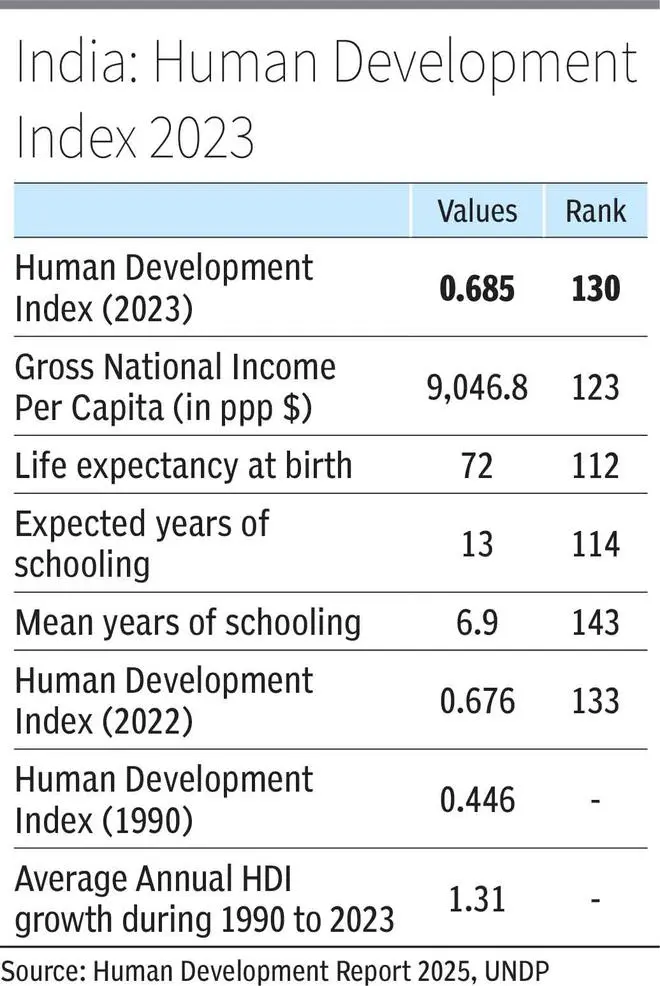The range of the India’s Human Development Index would have been a lot Higher if the population was stabilized in the year 2000 | Photocredit: V Raju
UNDP recently released the Human Development 2025 report. According to the report, India moved the Human Development Index (HDI) ranking from 133 in 2022 to 130 in 2023 from 193 countries. The HDI value improved from 0.676 in 2022 to 0.685 in 2023. The gross national income per head of the population is one of the components of HDI. In this context we discuss two issues here: (1) the progress of HDI over time; (2) Role of income per head of the population in the performance of the HDI of India.
We look at the progress of HDI in the period 1990 to 2023. The HDI value of India has risen from 0.446 in 1990 to 0.685 in 2023 – an increase of 53 percent in 33 years with the growth of 1.31 percent per year (see table). HDI for India moves faster than both the worldwide and the South Asian averages.

In the same period: (a) the gross national per head of the population increased from $ 2,167 to $ 9,048 – four times; (b) Life expectancy increased from 58.6 years to 72 years – an increase of 23 percent; (c) The expected years of training rose from 8.2 years to 13 years. These are important achievements in the era after the reform. India, however, lags behind many countries in the HDI rank. Other BRICS countries Russia (64), China (75), Brazil (84) South Africa and some other Asian countries such as Sri Lanka (78) Indonesia (113) and the Philippines (117) are above India, while Bangladesh (130) has a similar rank. In the South Asian region, only countries such as Nepal (145), Myanmar (149) and Pakistan (168) have lower ranks in HDI than India.
To make income
The Human Development Report says that India is in the category of medium -sized human development with an HDI value of 0.685 in 2023 and comes closer to the high threshold of human development of 0.700. However, it takes much longer before India catches up many Brics and Asian countries, because the income per head of the population is partly due to demographic pressure.
It can be noted that HDI is a summary of the average performance in important dimensions of human development: health, education and standard of living. The health dimension is assessed by life expectancy at birth, the education dimension is measured by average years of training for adults aged 25 and more and expected years of training for school children entering the age. The standard of the life dimension is measured by gross national income per head of the population.
It can be noted that one can analyze the progress of non-income indicators such as education, health, income or consumption over time. But converting all into an index forms different aggregation problems. In principle they must be independent.
Tn Srinivasan (2007) pointed out that “the merging of many relevant but not necessarily proportional dimensions in a single index defined as a randomly weighted sum of inexpensive indexes is little sense. The human development index indexia is an example of a arbitrary sum of non-condusional indexen.
Regarding HDI, the three components have equal weights. The GNI per head of the population has a third weight in the index. India is the 4th or 5th largest economy in the world in terms of GDP level and GDP is growing by 6-7 percent, which is the highest among the large economies. However, the income per head of the population of $ 9,047 (in PPP) is still very low compared to many other countries.
The table gives the ranks of the components of the HDI. The rank of GDP per capita (in PPP) in India is 123, while those of life expectancy and the expected years of training are 112 and 114 respectively. In other words, the rank of income per head of the population is much lower than the health component and one of the indicators of education. In the case of average years of training, another indicator for education, the rank of India is much lower at 143.
The income per head of the population in India is lower due to a higher population. If the Indian population had remained stable on, let’s say, 2000 level, the GNI per head of the population in India for the year 2025 would have been $ 12,282 (in ppp) with a rank of 114. In other words, HDI rang would have been much higher if the population was in -controlled in the BBP in the BP in the BP in the BP in the BP in the BP in the BP in the BP in the BP in the BP in the BP in the BP in the BP in the BP in the BP in the BP in the BP in the BP in the BP in the BP in the BP in the BP at the BP by the BP by the BP by the BP by the BP by the BP by the BP, the bbp in the BP in the BP. Limit HDI income.
HDI was evolved because the income did not clearly state human development. But the way in which income is included the calculation does not make it very different from the ranking that a country will come purely on the basis of income. An analysis shows that the rank correlation coefficient between the real GDP per head of the population and the human development index for all 193 countries is high at 0.97. However, it has been seen that only average medium-sized human developing countries are seen that the rank correlation coefficient with GDP index is lower at 0.78.
There are two conclusions from our analysis. The first is that the ranking according to the income per head of the population and the HDI ranking is very close. In the case of India, the low HDI ranking is partly due to the high population. Our rank in the HDI stays low with the population that continues to grow. This only shows the distance that we have to travel on income, which is an important part of HDI. We have no choice but to grow rapidly in view of the current level of income per head of the population.
Rangarajan is a former chairman, economic advisory board for the prime minister and former governor, RBI; DEV is former chairman, committee for agricultural costs and prices, and former Vice -Kanselier, Igidr, Mumbai
Published on June 7, 2025
#HDI #bias #lot #income




